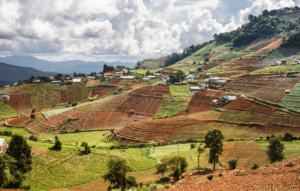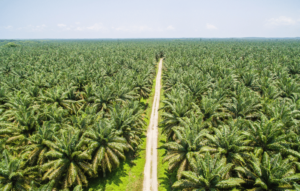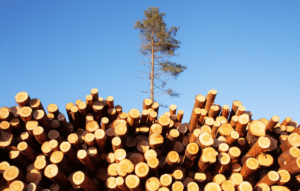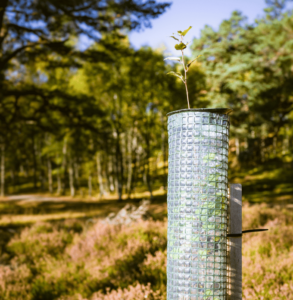Tree planting has become a global movement, one that is typically hailed as the quick fix for climate change and deforestation. Governments, corporations, and non-governmental organizations (NGOs) have launched massive initiatives, promising to plant billions – even trillions – of trees to offset carbon emissions and restore biodiversity. At first glance, these efforts appear to be a simple and effective way to heal our planet. But beneath the surface lies a much more complex and troubling reality.
Many of these tree-planting campaigns are actually driven by profit, not environmental stewardship. Instead of restoring ecosystems and supporting local communities, these initiatives often create man-made monoculture forests designed to produce fast-growing timber, palm oil, or other marketable resources. These man-made forests may boost short-term profits, but they come at a significant cost: biodiversity loss, soil degradation, and even increased carbon emissions.
In this blog, we’ll explore how tree planting, when driven by profit rather than ecological restoration, can end up exploiting nature rather than protecting it. By looking at the hidden costs of monoculture plantations and failed reforestation efforts, we’ll uncover the stark difference between profit-driven tree planting and genuine forest restoration.
The Boom of Profit-Driven Tree Planting
Tree planting, while an ancient practice, has taken on a new life in recent decades. In early civilizations like those of the Romans and Chinese, trees were planted strategically – for timber, shipbuilding, and land protection. These efforts were often localized, aimed at supporting immediate needs and ensuring resources for future generations. However, today’s tree-planting initiatives have transformed into global campaigns with lofty promises to combat climate change.
Modern reforestation efforts, such as the World Economic Forum’s One Trillion Trees initiative, are celebrated as a solution to the environmental crisis. These campaigns focus on planting trees at a massive scale, driven by the belief that more trees mean more carbon sequestered. As the world becomes more conscious of environmental sustainability, businesses, NGOs, and governments have latched onto the idea of tree planting as a simple, marketable solution to complex ecological problems.
trees mean more carbon sequestered. As the world becomes more conscious of environmental sustainability, businesses, NGOs, and governments have latched onto the idea of tree planting as a simple, marketable solution to complex ecological problems.
But behind the shiny promise of carbon offsets and greener landscapes, many of these initiatives are rooted in profit rather than genuine environmental recovery. Instead of restoring diverse ecosystems, these projects often focus on fast-growing, non-native species that are easy to commercialize. Whether it’s for timber, palm oil, or pulp, the goal is often to maximize economic returns while giving the illusion of environmental responsibility – AKA greenwashing. This shift has turned what could be a valuable tool for restoration into a practice that exploits both natural habitats and the communities that still have intimate relations with them.
The Environmental Cost of Monoculture Plantations
While tree planting initiatives have often been promoted as a means to restore forests and sequester carbon, the reality of profit-driven monoculture plantations can tell a different story. Unlike diverse, natural forests that support rich ecosystems, monoculture plantations focus on growing a single species – often fast-growing, non-native trees like eucalyptus, rubber, or palm oil. These plantations are designed to meet economic demands, but their environmental cost is steep.
Biodiversity Loss
Monoculture plantations have well-known negative impacts on biodiversity. Natural forests provide habitat for countless species of plants, animals, and microorganisms, each playing a role in maintaining the ecosystem’s balance. In contrast, monoculture plantations offer little to no habitat diversity. Studies in Southeast Asia, for example, show that converting tropical forests to palm oil plantations results in a severe loss of biodiversity, particularly affecting species like birds, amphibians, and lizards. Similar studies done in the Amazon also revealed significant species loss in areas converted to plantations, with the survival of only a few habitat generalists.

Soil and Water Degradation
Monoculture tree plantations often disrupt local water cycles and deplete soil health. Fast-growing species like eucalyptus and pine are notorious for their high water consumption, which can lead to the depletion of groundwater reserves. In regions where water is already scarce, like parts of Africa and South America, these plantations exacerbate local water shortages. Furthermore, the uniformity of monoculture forests can strip the soil of essential nutrients, leaving it vulnerable to erosion. This degradation makes it difficult for future ecosystems to thrive, even if efforts are made to restore natural forests.
Carbon Emissions Misconception
Contrary to popular belief, monoculture plantations are not always effective carbon sinks. In fact, they can be net carbon emitters, especially during the early stages of planting. The process of clearing land for plantations disturbs the soil, releasing stored carbon into the atmosphere. This effect is compounded when natural forests are replaced with monocultures, as old-growth forests are far more efficient at sequestering carbon over long periods. A recent study published in Nature revealed that old-growth forests can store carbon for centuries, whereas young plantations often contribute to carbon emissions due to soil disruption and the degradation of the previous ecosystem.
One of the most striking examples is the palm oil industry in Southeast Asia. Countries like Malaysia and Indonesia have converted vast areas of tropical rainforest into palm oil plantations, driven by global demand for this cheap and versatile oil. While palm oil is profitable, the environmental cost is staggering: deforestation, loss of species, soil degradation, and disruption of local water supplies. These plantations are designed to maximize economic returns, yet they decimate ecosystems that took centuries to develop.

How Corporations Exploit Tree Planting for Profit
Tree planting has become a popular tool for corporations looking to improve their public image, especially as environmental awareness grows among consumers. However, many of these tree planting campaigns are more about boosting profits and brand reputation than about genuinely restoring ecosystems. Behind slogans like “We plant a tree for every product sold” is often a system designed to maximize financial returns, while the actual ecological impact remains minimal – or even harmful.
Greenwashing Tactics
Corporate tree planting efforts often fall under the category of greenwashing, a term used to describe misleading environmental claims made by companies to appear more sustainable than they truly are. Tree planting is an easy marketing tool, as it presents a simple, feel-good solution to hyper-complex environmental issues. Consumers are led to believe that by purchasing a product, they are directly contributing to the fight against climate change, when in reality, the company may be cutting corners elsewhere in its environmental practices.
For example, fashion brands that rely heavily on unsustainable materials or exploitative labor practices often adopt tree planting campaigns to offset their environmental footprint. Yet these campaigns frequently involve planting fast-growing, non-native trees in monoculture plantations that do little to support biodiversity or the local environment. The focus is often on numbers – how many trees were planted – rather than the long-term impact on ecosystems.
Perverse Financial Incentives
Another major issue with corporate tree planting campaigns is the perverse incentives they create. Companies prioritize planting as many trees as possible, often without regard for where or how they are planted. This approach leads to plantations that may never mature into functional ecosystems, with saplings often failing to survive due to poor planning, insufficient resources, or inadequate maintenance.
A notorious example of this is Turkey’s “Breath for the Future” initiative, which set a world record by planting millions of trees in a single day in 2019. While the effort garnered international attention, it was later revealed that nearly 90% of the saplings died within months due to poor soil quality and a lack of rainfall. The project became a cautionary tale of how large-scale tree planting campaigns can fail when driven by the wrong incentives.
Profit-Driven Plantations
Beyond corporate greenwashing, tree planting is also a profitable venture in itself, especially in regions where fast-growing trees can be harvested for timber, paper, or other commercial products. Monoculture plantations, such as eucalyptus or palm oil, are often established under the guise of reforestation but are primarily intended to generate revenue.
The palm oil industry we mentioned earlier stands as the prime example. Major corporations invest heavily in palm oil plantations, especially in Southeast Asia, where they replace vast areas of biodiverse rainforest with monoculture palm trees. While these plantations are lucrative, producing one of the most in-demand agricultural products globally, they contribute to deforestation, biodiversity loss, and carbon emissions.
In Mexico, the government’s Sembrando Vida program, designed to promote reforestation, backfired when farmers were incentivized to clear natural forests to receive subsidies for planting new trees. As a result, the initiative led to the destruction of existing forests and the creation of monoculture plantations, which did more harm than good.
Monoculture Plantations vs. Real Forest Restoration
Not all tree planting efforts are created equal, and one of the most critical distinctions is between monoculture plantations and genuine forest restoration. While both approaches involve planting trees, their goals and impacts are vastly different. Monoculture plantations, which are often profit-driven, focus on a single species of tree, often low-key chosen for economic value. In contrast, forest restoration aims to revive ecosystems by fostering biodiversity, improving soil health, and supporting local communities.

Reforestation vs. Restoration
Monoculture plantations are often framed as reforestation, but the reality is that they fail to recreate the rich, diverse ecosystems of natural forests. These plantations prioritize economic outputs like timber, palm oil, or paper pulp, growing fast-growing species that can be harvested quickly for profit. As a result, they create a homogenous environment where only a few species can survive, stripping the area of its natural complexity.
In contrast, forest restoration goes beyond simply planting trees. It seeks to rebuild ecosystems that have been degraded or destroyed, reintroducing a variety of native species that provide habitats for wildlife, enhance soil fertility, and regulate water cycles. Forest restoration takes into account the specific needs of the local environment and ensures that the reforested area can support a broad range of species, from plants and animals to insects and microorganisms.
Impact on Wildlife and Ecosystems
Monoculture plantations are often inhospitable to wildlife, offering little in the way of food or shelter. These losses are compounded by the fact that monocultures often rely on heavy pesticide use to maintain their crops, further endangering local wildlife.
On the other hand, restored forests can act as a lifeline for endangered species. By planting native trees and allowing natural regeneration, forest restoration projects can provide critical habitats for animals and help revive entire ecosystems. For example, a study in Brazil’s Atlantic Forest found that forest restoration efforts created a 1,000-hectare corridor that allowed the critically endangered Black Lion Tamarin population to recover. This not only helped save the species from extinction but also improved the overall health of the forest.
Natural Regeneration
While planting trees is often the focus of reforestation efforts, natural regeneration can sometimes be a more effective solution. Natural regeneration allows forests to grow back on their own, without human intervention, by creating conditions that encourage the natural spread of native species. This process is often slower but can lead to more resilient ecosystems in the long run.
In some cases, assisted natural regeneration – where human intervention is used to protect and encourage the natural growth of trees – can be a more sustainable and cost-effective approach than planting new trees from scratch. By fencing off areas from grazing animals or controlling invasive species, local ecosystems can be restored in a way that mimics nature’s own processes. This approach often leads to stronger forests with higher biodiversity and much better long-term survival rates than monoculture plantations.
from grazing animals or controlling invasive species, local ecosystems can be restored in a way that mimics nature’s own processes. This approach often leads to stronger forests with higher biodiversity and much better long-term survival rates than monoculture plantations.
Final Thoughts
Tree planting has become a popular solution for combating climate change and restoring the environment, but it’s important to know that not all efforts are created equal. While the idea of planting trees is obviously appealing, many modern initiatives prioritize profit over ecological health, resulting in monoculture plantations that exploit nature rather than restore it. These man-made forests often lead to biodiversity loss, soil degradation, and even increased carbon emissions, while giving the false impression of environmental responsibility.
The difference between monoculture plantations and genuine forest restoration is stark. True restoration efforts focus on bringing ecosystems back to life by fostering biodiversity, improving soil and water systems, and engaging local communities in sustainable land management. Examples like Brazil’s Black Lion Tamarin Conservation Program show that when done thoughtfully, reforestation can provide both environmental and social benefits.
Moving forward, supporting tree planting initiatives that prioritize native species, involve local communities, and focus on long-term survival over sheer numbers is critical. By promoting natural regeneration and forest restoration rather than profit-driven monocultures, we can ensure that tree planting efforts genuinely contribute to healing our planet – both for today and for future generations.








